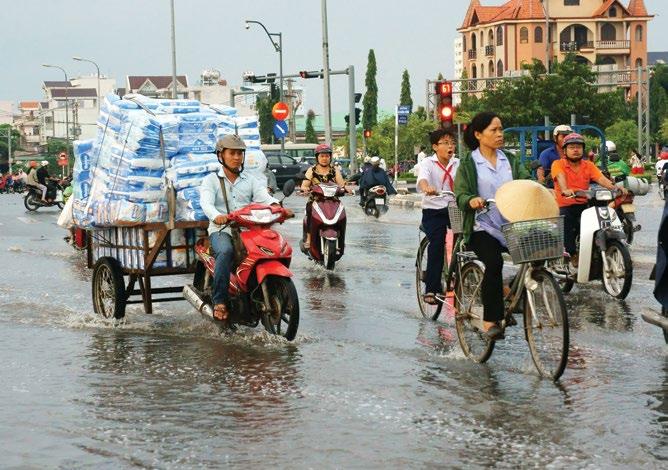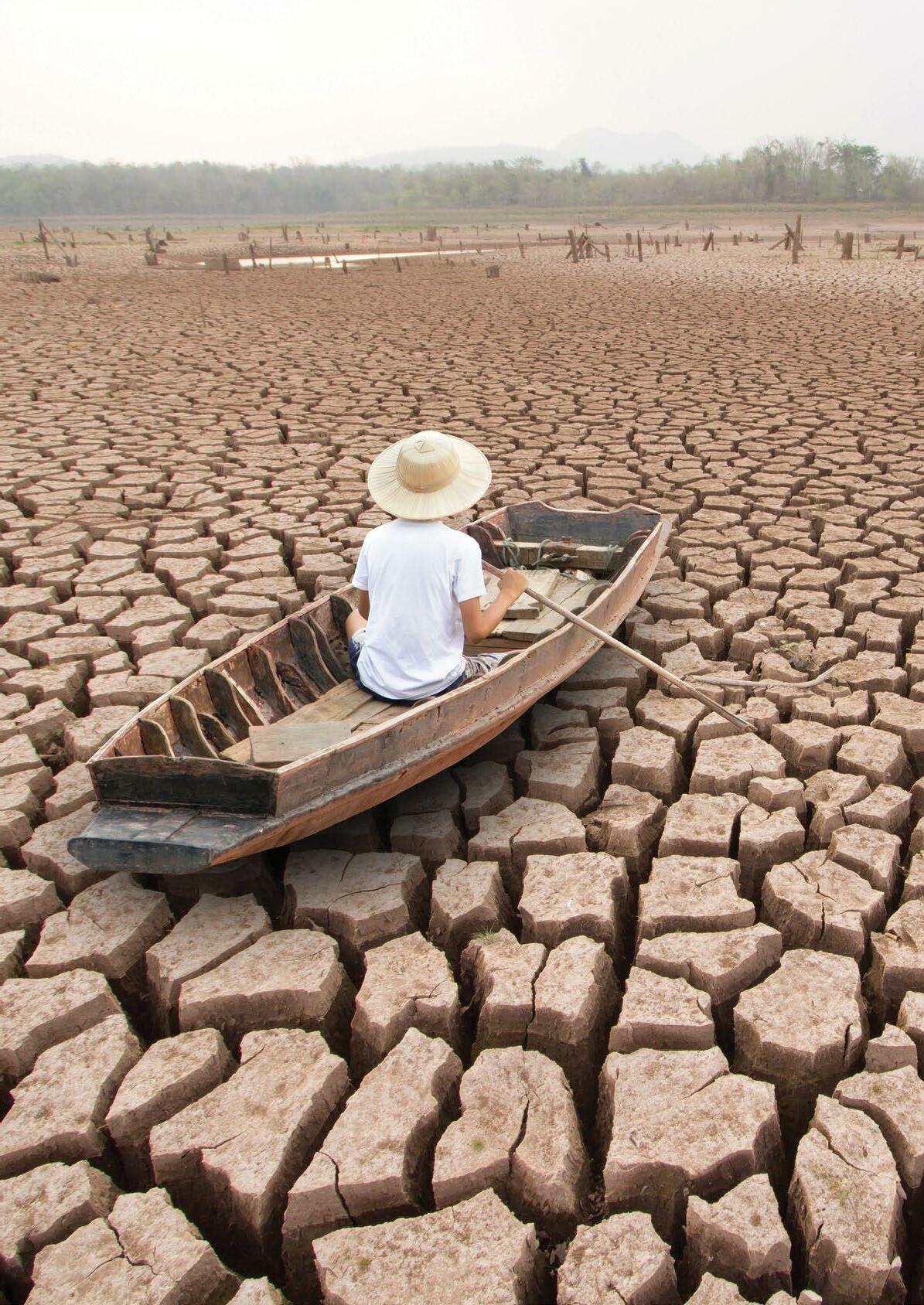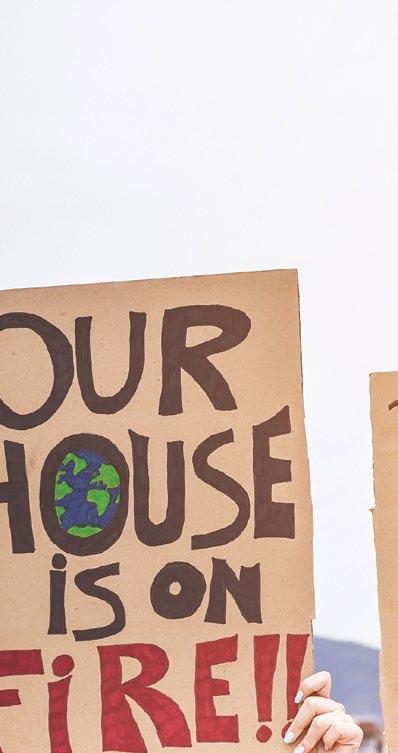
8 minute read
‘Climate refugees’: The expected climate change migration
from Global-is-Asian 2020 issue
by Lee Kuan Yew School of Public Policy, National University of Singapore
Featured Faculty: Vinod Thomas Visiting Professor, Lee Kuan Yew School of Public Policy
I share the same concern, we all should. We need to make changes and not small ones like switching to a cloth bag or doing away with plastic. We need to leave behind carbon-intensive fuels for greener options like solar, wind, and other forms of renewable energies. It’s about switching to more sustainable options, or like Professor Vinod called it, “a climate-benign” method. ”
The above excerpt is from a user comment on BIGWIG. The earth’s temperature is increasing at a rate faster than scientists previously predicted. Global warming has reached one degree Celsius above pre-industrial levels for the first time, while the 10 warmest years on record have all occurred since 1998, nine of which were after 2005.
Southeast Asia is one of the regions most heavily affected by the planet’s rising temperature, and the impacts are being felt in the form of rising sea levels, increasingly frequent and extreme weather patterns, and intensifying heavy rainfall.
The rising temperatures have impacts on everyone, but some communities — especially those in developing countries — are more adversely affected by climate change. In Southeast Asia, there are already families and communities who have been forced to leave their homes in search of livelihoods elsewhere because of the direct effects seen from the heating of the planet.
This includes resource scarcity such as that of drinking water, destroyed crops that contribute to a loss of livelihoods, and increased frequency of extreme weather patterns that make areas become too dangerous, hot or wet to be inhabitable. Emergence of climate refugees
People being forced from their homes due to climate change are commonly referred to as “climate refugees”, although this is not a term that exists in international law. According to the 1952 Convention relating to the Status of Refugees, a refugee is defined as a person who has crossed an international border “owing to well-founded fear of being persecuted for reasons of race, religion, nationality, membership of a particular social group or political opinion”. United Nations High Commissioner for Refugees (UNHCR) does not endorse the term, and instead refers to them as “persons displaced in the context of disasters and climate change”.
According to Visiting Professor Vinod Thomas at the Lee Kuan Yew School of Public Policy, climate refugees are those who are forced to move from their homes and places of livelihood because of climate change impacts of water scarcity, crop failure, sea-level rise and storm surges.
“The number of people being displaced by disasters worldwide are already staggering: this figure stands at over 25 million a year since 2008. Most of these disasters were estimated to be climaterelated, with two-thirds of the displacement in East Asia and the Pacific. The World Bank estimated in 2018 that the worsening impacts of climate change in South Asia, Africa and Latin America would also lead to over 140 million people moving within their countries’ borders by 2050,” he says.
Scientific projections suggest that if global temperatures are allowed to exceed 1.5 degrees Celsius over historic levels, many more areas will become uninhabitable. As agricultural terrain becomes climate non-resistant, migration will continue to grow to unacceptable levels as the climate crisis comes to a boil. Climate change in Southeast Asia
In Southeast Asia, average temperatures have increased every decade since 1960. Data from the Meteorological Services Singapore revealed that the nation’s annual mean temperature has risen from approximately 26.7 degrees Celsius in 1960, to 28.4 degrees Celsius in 2019. According to the Global Climate Risk Index, compiled by the environmental group Germanwatch, Myanmar, the Philippines, Vietnam and Thailand are among the 10 countries in the world which were most affected by climate change in the past 20 years. In 2018, the Philippines was the second most affected country in the world by climate change, behind Japan.


South Asia is also highly exposed to both floods and heatwaves, while China has seen some of the worst flooding in its history lately. Many other countries in Southeast Asia, including Singapore, are especially vulnerable to a rise in sea-levels and flooding.
“A sea-level rise of two metres could displace 187 million people. The Pacific islands are at a high risk: for instance, Fiji, Papua New Guinea and Vanuatu have already started relocating vulnerable populations,” says Professor Thomas.
Despite everything, Southeast Asia, according to the IMF, “is witnessing the world’s biggest jump in greenhouse gas emissions.” This sobering verdict spells out how this region is among the most exposed and most vulnerable to the climate crisis and yet it is among the least prepared.
For example, in Myanmar, some communities living close to rivers have been forced to move due to rising sea levels or the erosion of river banks. Those living close to the Mekong River in Vietnam have reported increased floods that are devastating communities, destroying crops, and livelihoods.
The situation is only likely to get worse. According to a 2017 study by the Asian Development Bank and the Potsdam Institute for Climate Impact Research, the Asia Pacific region could witness a “new climate regime” by the end of this century, with the coldest summer months at the end of the 21st century projected to be warmer than the hottest summer months between 1951 and 1980.
The study found that in Indonesia, the Philippines, Thailand and Vietnam, rice yields could decline by up to 50% by 2100 when compared to 1990 levels, and that climate change will pose a “serious threat
Visiting Professor Vinod Thomas
to food security” in the sub-region. In addition, warmer weather is also pushing tropical diseases such as malaria and dengue further northward to countries like Lao PDR.
Dealing with climate refugees
Amid this catastrophic scenario then, what can be done? As mentioned above, the term “climate refugee” is not recognised in international law, complicating the legislative approach to the issue. Given the projected numbers of people who may be displaced now or in the future by climate change, this is concerning.
As the issue becomes increasingly important, particularly amid the COVID-19 pandemic that has burdened already vulnerable communities, there are discussions about how the legal status of “climate refugees” can be addressed.
An idea that has been suggested has been to take the hybrid law approach, which can be engaged for their protection. A hybrid law approach would examine climate change from the perspectives of environmental law, human rights law and refugee law. An underlying cause can be found in environmental law, which brings about climate change, which, in turn, impacts human rights law, due to its impact on the target society. The rights violation then creates refugees who migrate in order to protect their human rights.
Such an approach, experts argue, would lead to principles and instruments being located in existing international law, rather than the need to create new legal obligations.
Since developing countries typically feel the adverse effects of climate change, increasing responsibility must be placed on developed countries to address their climate change obligations and also to house climate refugees.

Visiting Professor Vinod Thomas

The world is ill-prepared to respond
“We can expect massive human migration from resource scarcity, increased frequency of extreme weather events, droughts, and distress to agriculture. But the unfortunate truth is that the world is ill-prepared for this scenario. The developed countries need to recognise the size of the problem and be willing to invest in stemming the tide in the interest of the world and not just their own,” says Professor Thomas.
But curiously, the single most important response is climate mitigation — switching economies from a carbon-intensive to a low carbon growth path. Without doing so, no amount of adaptation and humanitarian help will be able to keep up with the growing problem. He continues, “It is as though one is trying to mop the floor continuously without turning off the tap that is causing the flooding.”
From his point of view, Southeast Asia should focus far more forcefully on building climate resilience. One case in point is to invest in climate resilient varieties in agriculture, strengthening irrigation infrastructure, improving regional water cooperation, and fostering insurance and safety nets for people.
“This region is not doing nearly enough in these respects. While Singapore is investing in climate adaptation through building seawalls and better drainage, it must do far more to foster regional action. Singapore also needs to invest more in climate mitigation, by switching to renewable energy, cutting on airconditioning, and stopping carbon intensive imports and trade,” he says.
Looking at the state of the current world leadership, it is also evident that they are not ready to handle the situation. The World Migration Report 2020 from International Organisation for Migration points out how ill-prepared the world is to respond. “When one thinks of the responsibility for the climate catastrophe, the largest emitters are China, the United States, India, Russia, Japan, the European Union. The current US administration has pursued an anti-climate change mitigation policy. On the other hand, China has announced zero carbon plans for 2060, but the sense of urgency for action before 2030 is desperately needed. Apart from China, India and Southeast Asia should also look to renewable fuels like solar and wind instead of relying on coal, oil and natural gas,” says Professor Thomas.
As the climate crisis wears on, urgent and meaningful action is needed from every corporation, every government entity and every single human being — before it’s too late.











